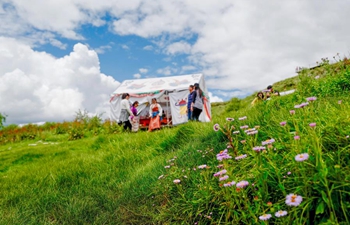URUMQI, Aug. 6 (Xinhua) -- It's tourism season, and Bolat Huanale, from Kazakhstan, drives tourists in his white minibus across his country's border with China five times a day through the port of Horgos in northwest China's Xinjiang Uygur Autonomous Region.
Horgos, meaning "a place where caravans pass" in Mongolian, was once a busy passage used by traders traveling along the ancient Silk Road. It became a land port in 1881. Although caravans have faded into history, today fleets of vehicles like Huanale's gather at the port, which has been revitalized by the Belt and Road Initiative, proposed by China in 2013.
Hundreds of Kazakhstani tourists gathered in front of a shopping mall, carrying huge bags, pushing hand trucks and waiting to board the buses back home after a shopping trip to the China-Kazakhstan International Border Cooperation Center, the world's only duty-free shopping center spanning two countries, which opened in 2012.
A woman named Xugela was among the tourists. She and her daughter got up early in the morning and took a bus from Almaty, 370 kilometers away, for four hours to get here. After a day-long trip, their two hand trucks were loaded with six large boxes containing bedding, one of the most popular Chinese goods among Kazakhstani shoppers.
"With their good quality, things here are a lot cheaper than in our country, so we come shopping here several times a month," said Xugela, pushing her luggage onto Huanale's bus. It was crowded, and there was barely room left for luggage.
Yespoli Mijiti was already resting on board. He had waited at the Kazakhstan border even when it was still dark in the morning just to buy a self-balancing scooter as a present for his younger brother.
"Some day I will travel along the Silk Road deep into the inland of China," said Mijiti.
The Kazakhstani tourists didn't just come from nearby towns and cities like Zharkent, some 40 km away from Horgos, and Almaty, but also from places more than 1,000 km away.
It was Kulzat Turdebek's first time to Horgos. She set off from Shymkent, spent two days on a train to Almaty, and took a bus to the border. Her friends and neighbors had recommended Chinese goods for her, so she decided to go and take a look.
Turdebek went on a shopping spree. She spent about 6,000 yuan (878 U.S. dollars) on a scooter and toys for her child as well as many household goods.
According to the border control station in Horgos, 5.54 million Chinese and foreigners crossed the border in 2017 via the Horgos cooperation center, 33 times the number in 2012 when the center opened. The trade volume in the center reached 11.7 billion yuan last year, up 180 percent year on year.

















